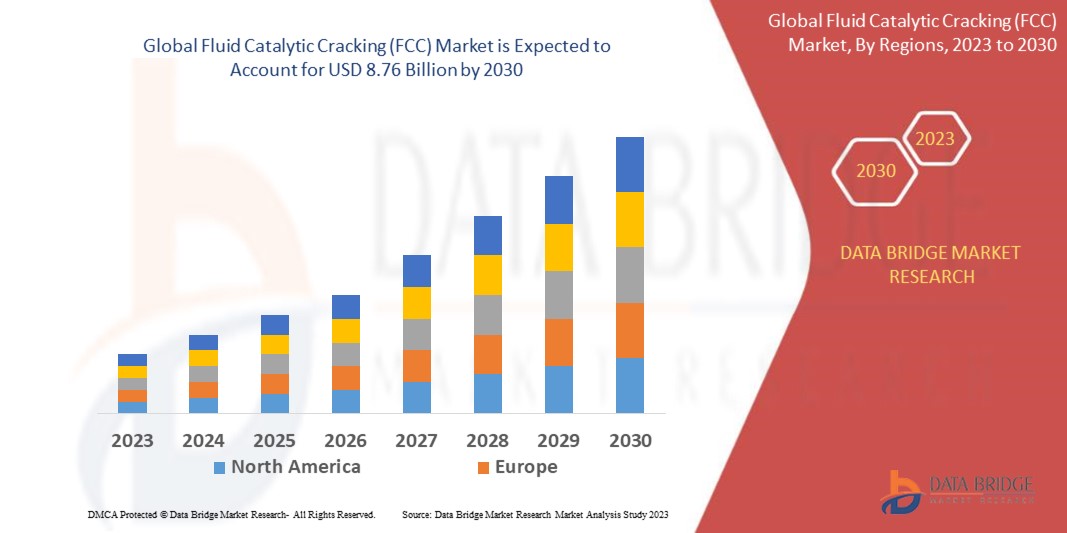Global Fluid Catalytic Cracking Fcc Market
Market Size in USD Billion
CAGR :
% 
 USD
6.73 Billion
USD
8.76 Billion
2022
2030
USD
6.73 Billion
USD
8.76 Billion
2022
2030
| 2023 –2030 | |
| USD 6.73 Billion | |
| USD 8.76 Billion | |
|
|
|
|
Global Fluid Catalytic Cracking (FCC) Market, By Type (Lanthanum Oxide, Zeolite), Category (LVR-60, ORBIT-3600, CHV-1, RAG-7), Technical Configuration (Side-By-Side Type, Stacked Type), Application (Chemical, Others) - Industry Trends and Forecast to 2030.
Fluid Catalytic Cracking (FCC) Market Analysis and Size
Fluid catalytic cracking (FCC) is a process in the petroleum refining industry. It involves the conversion of heavy hydrocarbon feedstocks into lighter, more valuable products such as gasoline, diesel, and jet fuel. FCC utilizes a powdered catalyst and a fluidized bed reactor to break down complex hydrocarbon molecules through a combination of thermal cracking and catalytic reactions.
Data Bridge Market Research analyses that the fluid catalytic cracking (FCC) market which was USD 6.73 billion in 2022, would rocket up to USD 8.76 billion by 2030, and is expected to undergo a CAGR of 3.35% during the forecast period of 2023 to 2030.
“Zeolite” dominates the type segment of the fluid catalytic cracking (FCC) market due to its superior catalytic properties, high stability, and widespread usage in the petroleum refining industry. In addition to the insights on market scenarios such as market value, growth rate, segmentation, geographical coverage, and major players, the market reports curated by the Data Bridge Market Research also include in-depth expert analysis, geographically represented company-wise production and capacity, network layouts of distributors and partners, detailed and updated price trend analysis and deficit analysis of supply chain and demand.
Fluid Catalytic Cracking (FCC) Market Scope and Segmentation
|
Report Metric |
Details |
|
Forecast Period |
2023 to 2030 |
|
Base Year |
2022 |
|
Historic Years |
2021 (Customizable to 2015-2020) |
|
Quantitative Units |
Revenue in USD Million, Pricing in USD |
|
Segments Covered |
By Type (Lanthanum Oxide, Zeolite), Category (LVR-60, ORBIT-3600, CHV-1, RAG-7), Technical Configuration (Side-By-Side Type, Stacked Type), Application (Chemical, Others) |
|
Countries Covered |
North America (U.S., Canada, and Mexico), South America (Brazil, Argentina, and Rest of South America), Europe (Germany, France, Italy, U.K., Belgium, Spain, Russia, Turkey, Netherlands, Switzerland, and Rest of Europe), Asia-Pacific (Japan, China, India, South Korea, Australia, Singapore, Malaysia, Thailand, Indonesia, Philippines, and Rest of Asia-Pacific), Middle East and Africa (U.A.E., Saudi Arabia, Egypt, South Africa, Israel, and Rest of the Middle East and Africa) |
|
Market Players Covered |
Albemarle Corporation (U.S.), W.R. Grace Company (U.S.), BASF SE. (Germany), Johnson Matthey (U.K.), Arkema (France), JGC CORPORATION (Japan), Flour Corporation (U.S.), Shell (U.K.), Honeywell International Inc. (U.S.), Exxon Mobil Corporation. (U.S.), CLG (U.S.), McDermott (U.S.), and Axens (France), Kuwait Catalyst Company (Kuwait), N.E. CHEMCAT (Japan), Porocel Corporation (U.S.), Yueyang Sciensun Chemical Co., Ltd. (China), DuPont (U.S.) and Magma Ceramics & Catalysts (U.K.) |
|
Market Opportunities |
|
Market Definition
Fluid catalytic cracking (FCC) is a secondary unit operation used to produce added gasoline in the refining course. Fluid catalytic cracking (FCC) is a chemical process that promotes a catalyst and heat to break long-chain hydrocarbons into smaller-chain hydrocarbons.
Fluid Catalytic Cracking (FCC) Market Dynamics
Drivers
- Increasing Demand for Transportation Fuels
The rising global demand for gasoline, diesel, and jet fuel is a key driver for the FCC market. FCC enables the production of higher yields of these fuels from heavy hydrocarbon feedstocks.
- Growing Refining Capacity
The expansion of refinery capacities, particularly in emerging economies, drives the demand for FCC technologies to efficiently convert crude oil into valuable petroleum products.
Restraints
- Environmental Concerns
FCC processes generate emissions and contribute to air pollution. Increasing environmental regulations and the need for cleaner fuels pose challenges for the FCC industry to meet stringent emission standards.
Opportunities
- Technological Advancements
Ongoing research and development efforts are focused on improving FCC catalysts, reactor designs, and process efficiency, presenting opportunities for innovation and enhanced performance.
Challenges
- High Costs and Feedstock Composition
The high investment, as well as operational costs associated with the fluid catalytic cracking (FCC), are projected to create hindrances for the growth of the fluid catalytic cracking (FCC) market. Moreover, another major concern for refinery operators is feedstock composition, which includes issues with heat and configuration balance and contaminants. This factor will also hamper the market growth.
This fluid catalytic cracking (FCC) market report provides details of new recent developments, trade regulations, import-export analysis, production analysis, value chain optimization, market share, the impact of domestic and localized market players, analyses opportunities in terms of emerging revenue pockets, changes in market regulations, strategic market growth analysis, market size, category market growths, application niches and dominance, product approvals, product launches, geographic expansions, technological innovations in the market. To gain more info on the fluid catalytic cracking (FCC) market contact Data Bridge Market Research for an Analyst Brief, our team will help you make an informed market decision to achieve market growth.
Recent Development
- In December 2022, Iraq had secured a funding of USD 897 million from Japan for the expansion of the Basrah Refinery under Phase 4 of the project. The loan agreement, signed between Iraq's Ministry of Finance and Japan, aims to develop the refinery by installing a new fluid catalytic cracking (FCC) complex, which will be the first of its kind in the country.
Global Fluid Catalytic Cracking (FCC) Market Scope
The fluid catalytic cracking (FCC) market is segmented on the basis of type, category, technical configuration, and application. The growth amongst these segments will help you analyze meagre growth segments in the industries and provide the users with a valuable market overview and market insights to help them make strategic decisions for identifying core market applications.
Type
- Lanthanum Oxide
- Zeolite
Category
- LVR-60
- ORBIT-3600
- CHV-1
- RAG-7
Technical Configuration
- Side-By-Side Type
- Stacked Type
Application
- Chemical
- Others
Fluid Catalytic Cracking (FCC) Market Regional Analysis/Insights
The fluid catalytic cracking (FCC) market is analysed and market size insights and trends are provided by type, category, technical configuration, and application are referenced above. The countries covered in the Fluid Catalytic Cracking (FCC) market report are U.S., Canada, and Mexico in North America, Brazil, Argentina, and Rest of South America in South America, Germany, France, Italy, U.K., Belgium, Spain, Russia, Turkey, Netherlands, Switzerland, and Rest of Europe in Europe, Japan, China, India, South Korea, Australia, Singapore, Malaysia, Thailand, Indonesia, Philippines, and Rest of Asia-Pacific in Asia-Pacific, and U.A.E., Saudi Arabia, Egypt, South Africa, Israel, and Rest of the Middle East and Africa in Middle East and Africa.
Asia-Pacific is estimated to lead the fluid catalytic cracking (FCC) market due the high investment as well as increase in refining activity within the region.
North America is expected to expand at a significant growth rate over the forecast period from 2023 to 2030 due to the high consumption of petroleum-based products and wide availability within the region.
The country section of the report also provides individual market impacting factors and changes in regulation in the market domestically that impact the current and future trends of the market. Data points such as down-stream and up-stream value chain analysis, technical trends, and porter's five forces analysis, case studies are some of the pointers used to forecast the market scenario for individual countries. Also, the presence and availability of global brands and their challenges faced due to large or scarce competition from local and domestic brands, the impact of domestic tariffs, and trade routes are considered while providing forecast analysis of the country data.
Competitive Landscape and Fluid Catalytic Cracking (FCC) Market Share Analysis
The fluid catalytic cracking (FCC) market competitive landscape provides details by competitors. Details included are company overview, company financials, revenue generated, market potential, investment in research and development, new market initiatives, global presence, production sites and facilities, production capacities, company strengths and weaknesses, product launch, product width, and breadth, application dominance. The above data points provided are only related to the companies' focus related to the fluid catalytic cracking (FCC) market.
Some of the major players operating in the fluid catalytic cracking (FCC) market are
- Albemarle Corporation (U.S.)
- W.R. Grace Company (U.S.)
- BASF SE. (Germany)
- Johnson Matthey (U.K.)
- Arkema (France)
- JGC CORPORATION (Japan)
- Flour Corporation (U.S.)
- Shell (U.K.)
- Honeywell International Inc. (U.S.)
- Exxon Mobil Corporation. (U.S.)
- CLG (U.S.)
- McDermott (U.S.)
- Axens (France)
- Kuwait Catalyst Company (Kuwait)
- N.E. CHEMCAT (Japan)
- Porocel Corporation (U.S.)
- Yueyang Sciensun Chemical Co., Ltd. (China)
- DuPont (U.S.)
- Magma Ceramics & Catalysts (U.K.)
SKU-
Get online access to the report on the World's First Market Intelligence Cloud
- Interactive Data Analysis Dashboard
- Company Analysis Dashboard for high growth potential opportunities
- Research Analyst Access for customization & queries
- Competitor Analysis with Interactive dashboard
- Latest News, Updates & Trend analysis
- Harness the Power of Benchmark Analysis for Comprehensive Competitor Tracking
Global Fluid Catalytic Cracking Fcc Market, Supply Chain Analysis and Ecosystem Framework
To support market growth and help clients navigate the impact of geopolitical shifts, DBMR has integrated in-depth supply chain analysis into its Global Fluid Catalytic Cracking Fcc Market research reports. This addition empowers clients to respond effectively to global changes affecting their industries. The supply chain analysis section includes detailed insights such as Global Fluid Catalytic Cracking Fcc Market consumption and production by country, price trend analysis, the impact of tariffs and geopolitical developments, and import and export trends by country and HSN code. It also highlights major suppliers with data on production capacity and company profiles, as well as key importers and exporters. In addition to research, DBMR offers specialized supply chain consulting services backed by over a decade of experience, providing solutions like supplier discovery, supplier risk assessment, price trend analysis, impact evaluation of inflation and trade route changes, and comprehensive market trend analysis.
Research Methodology
Data collection and base year analysis are done using data collection modules with large sample sizes. The stage includes obtaining market information or related data through various sources and strategies. It includes examining and planning all the data acquired from the past in advance. It likewise envelops the examination of information inconsistencies seen across different information sources. The market data is analysed and estimated using market statistical and coherent models. Also, market share analysis and key trend analysis are the major success factors in the market report. To know more, please request an analyst call or drop down your inquiry.
The key research methodology used by DBMR research team is data triangulation which involves data mining, analysis of the impact of data variables on the market and primary (industry expert) validation. Data models include Vendor Positioning Grid, Market Time Line Analysis, Market Overview and Guide, Company Positioning Grid, Patent Analysis, Pricing Analysis, Company Market Share Analysis, Standards of Measurement, Global versus Regional and Vendor Share Analysis. To know more about the research methodology, drop in an inquiry to speak to our industry experts.
Customization Available
Data Bridge Market Research is a leader in advanced formative research. We take pride in servicing our existing and new customers with data and analysis that match and suits their goal. The report can be customized to include price trend analysis of target brands understanding the market for additional countries (ask for the list of countries), clinical trial results data, literature review, refurbished market and product base analysis. Market analysis of target competitors can be analyzed from technology-based analysis to market portfolio strategies. We can add as many competitors that you require data about in the format and data style you are looking for. Our team of analysts can also provide you data in crude raw excel files pivot tables (Fact book) or can assist you in creating presentations from the data sets available in the report.














